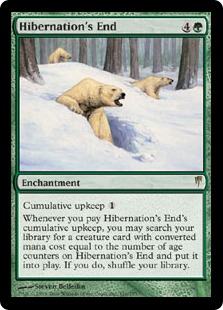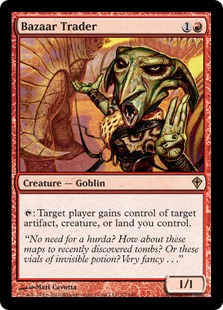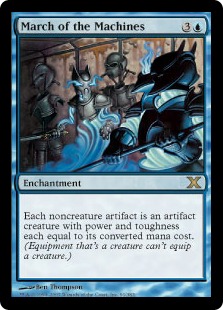
Cranial Insertion
March of the Questions
or, Is it Spring yet?
By Eli Shiffrin, Brian Paskoff, and Carsten Haese
March of the Questions
or, Is it Spring yet?
By Eli Shiffrin, Brian Paskoff, and Carsten Haese

The end of Winter is near
One thing that will never outlast my capacity to enjoy it is the steady stream of questions that march into our inbox at [email]cranial.insertion@gmail.com[/email] and keep feeding this series. Please keep 'em coming. In addition to being answered by our writers by email, your questions may appear in a future issue.
So, before I can make another March/march pun, let's march, sorry, dive right into this week's selection of rules questions. We'll start off with a followup from last week.
Q: I have a followup question to your Sacred Grounds question from last week. Why isn't the Lightning Bolt considered to be the cause of Raging Ravine going to the graveyard?
A: Sacred Ground only looks for the direct cause, which is whatever is happening at the moment the land is put into the graveyard. In this case, that's the execution of the state-based action that destroys creatures with lethal damage. This cause may have been caused by your opponent's Lightning Bolt, but Sacred Ground doesn't follow the chain of events that far back.
Q: If I control a Kitesail Apprentice and equip it with Magebane Armor, will Kitesail Apprentice fly like an eagle or walk like an Egyptian?
A: It'll walk, although maybe not like an Egyptian. The continuous effect that wants to give the Apprentice flying has a timestamp that coincides with when it entered the battlefield. The timestamp of Magebane Armor's effect is set when the equip ability resolved, which is necessarily later than the former. The later effect wins, so your Kitesail Apprentice will be on foot.
Q: I control a Sejiri Steppe and a Ruin Ghost, both untapped, and my opponent attacks me with a Leatherback Baloth. In the Declare Attackers step, he casts a kicked Vines of Vastwood on it for the win. Can I respond by tapping Sejiri Steppe for , tap Ruin Ghost to flicker Sejiri Steppe, and give the Baloth protection from green to counter the Vines?
A: No, that won't work quite like that, since Sejiri Steppe's ability can only target a creature you control. However, you could chump-block the Baloth with Ruin Ghost, and then give Ruin Ghost protection from green. That way, you won't take any damage at all unless your opponent has a surprise trample-giving spell up his sleeve.
Q: If I control a Calcite Snapper and Glory of Warfare, the Snapper would be a 3/4 on my turn. What will it become when I play a land?
A: Effects that switch power and toughness are always applied last. As you go through the layers, your Snapper starts as 1/4, then gets +2/+0, and then its power and toughness are switched, so the end result is 4/3. Note that you could also keep it as 3/4, since the landfall ability is optional.
Q: Does Chandra Ablaze's ultimate ability help me build up a storm count?
A: Certainly! Chandra's ability lets you cast spells. Storm counts how many spells you have cast. The fact that Chandra's ability lets you cast the spells from your graveyard doesn't matter. Storm counts the spells regardless from where you cast them.
Q: I cast Ajani Vengeant and target one of my opponent's x/3 creatures with the -2 ability. In response, he casts Vines of Vastwood on his creature so I can't deal damage to it. The life gain isn't dependent on the damage, so I should still gain life, shouldn't I?
A: While it's true that the life gain isn't dependent on the damage, you still won't gain any life in this case. When Ajani's ability resolves, its only target has become illegal, so the ability is countered on resolution and none of its effects happen. On the other hand, if your opponent had responded with Healing Salve to prevent the damage, the ability would have resolved and you still would have gained life.

That's one bizarre trader
A: No, it won't. Soul's Fire's targeting requirement is "target creature you control." Soul's Fire rechecks its targets when it resolves, and if you traded away your Thoctar in response to Soul's Fire, your Thoctar is no longer a legal target. Soul's Fire isn't countered because it still has you as a legal target, so it'll do as much as possible, but since it can't make the illegal target do stuff, as much as possible means a whole lot of nothing.
Q: I'm playing a game of Two-Headed Giant, and I control Ageless Entity. If my teammate gains life, does my Ageless Entity get counters?
A: Nope, sorry. Let's recall the fundamental paradox of Two-Headed Giant: Teams have life totals, but teams don't gain or lose life. Players gain and lose life individually, but they don't have life totals. Those two facts are reconciled by the fact that a player's life gain or loss is applied to that player's team's life total. To illustrate this concept, imagine that your team's life total is a room that stores a pile of gold coins. There are two doors leading into that room, on opposite sides of that room, but both doors lead to the same pile of coins. One door represents you, and the other door represents your teammate. If a player gains life, a little gnome brings coins into the room through the corresponding door and dumps them onto the pile. If a player loses life, the gnome goes in through the corresponding door, takes some coins from the pile, and leaves through the same door.
In terms of this illustration, Ageless Entity looks for the gnome to bring coins through your door, and if that happens, Ageless Entity is so happy that it grows. When your teammate gains life, the gnome goes through the door on the opposite side, and Ageless Entity doesn't see what's going on on that side, so its ability doesn't trigger.
Q: The game between my opponent and me is down to to wire, and I'll be able to finish him off if I survive into my next turn. Unfortunately, my opponent just cast a hasty beatstick that will kill me first if I let it deal damage to me. The only answer I have in my hand is Hallow. Will that do the trick?
A: Yes, it will! Hallow can target a creature spell on the stack, and the resulting prevention effect will apply to the permanent that the creature spell becomes. All of a sudden, your opponent won't feel very motivated to attack you with his beatstick, so you bought yourself a bit of time.
Quote fromPrevention effects that apply to damage from a permanent spell on the stack continue to apply to damage from the permanent that spell becomes.
Q: My opponent controls two Rod of Ruin and pings me with both of them. Then he casts March of the Machines, so the Rods are now creatures. Can I cast Inferno Trap for its trap cost now?
A: No. The condition "If you've been dealt damage by two or more creatures this turn" looks at the events that happened to you over the turn. What happened to you is that artifacts dealt damage to you, so the trap condition is not fulfilled.
If the condition were "If two or more creatures dealt damage to you this turn", then the game would look at all objects that are now creatures and checks their history to see if those objects dealt damage to you, regardless of what they were at the time they dealt damage. However, that's not how Inferno Trap is written.
Q: I control Dralnu, Lich Lord and four Burning-Eye Zuberas. My opponent casts Molten Disaster for X=4, and I choose to sac my Zuberas to Dralnu's replacement effect. Does the Zuberas' ability trigger?
A: Nope. Dralnu's replacement effect modifies the damage event so that the four Zuberas are sacrificed at the same time as they're dealt 4 damage. Their ability is a leave-the-battlefield ability which looks back to right before the event to see if they should trigger. Right before the damage event, the Zuberas hadn't been dealt damage yet, so their ability doesn't trigger.
Q: I have an Eldrazi Monument out, so all my dudes are indestructible. One of those dudes is a Devoted Druid. Since the Druid is indestructible, can I put a million -1/-1 counters on it to get a million mana out of it and do something stupidly amazing with that mana?
A: That won't work. After you put the second counter on, the Druid's toughness drops to 0, and state-based actions move the Druid to your graveyard. This is not destruction, so being indestructible doesn't help it survive.
Q: I'm playing against a Dark Depths deck, and my opponent opens with the dreaded Turn 1 Urborg, Tomb of Yawgmoth, Turn 2 Dark Depths/Vampire Hexmage. Can I throw a wrench into his plan with Smallpox?
A: Yes, that'll do nicely. If he makes Marit Lage first, he'll have to sacrifice it and Urborg to Smallpox. If he doesn't, the Smallpox will claim his Hexmage and either Urborg or Dark Depths. Either way, you've slowed him down significantly.
Q: I control Uphill Battle, and my opponent casts a big juicy creature that I take for myself with Gather Specimens. Does the creature enter the battlefield tapped?
A: Strangely enough, yes. Even though it enters the battlefield under your control, it was cast by your opponent, so Uphill Battle makes it enter the battlefield tapped.

March of the corner-cases
A: That is an impressively elaborate setup you've constructed there, but unfortunately it doesn't work. Protection from everything is a special case that includes the fact that Progenitus can't be the target of abilities from any source. Not even abilities from sources with no characteristics whatsoever can target it. Also, even if a source without characteristics could target Progenitus, your typeless and colorless permanent still has plenty of characteristics left, such as name and mana cost, just to name a few.
Q: My opponent has a suspended Aeon Chronicler that is about to pop out of suspension. Can I respond to the removal of the last time counter with Silence, Time Stop, or Stifle to keep the Chronicler in exile forever?
A: Yes, that works. When the last counter is removed, a triggered ability triggers that instructs your opponent to cast Aeon Chronicler. That ability goes on the stack and you can respond to it. If you respond with Silence, your opponent suddlenly finds himself unable to cast the Chronicler when the ability resolves. If you respond to the ability with Time Stop or Stifle, the ability is removed from the stack and doesn't resolve at all. In both cases, there are no time counters left on the Chronicler, so it'll be stranded in exile indefinitely.
Q: How does Pursuit of Knowledge interact with Brainstorm?
A: They interact really well, in fact. Brainstorm instructs you to draw three cards, which you draw one at a time. Each of those draws can be replaced by putting a study counter on Pursuit of Knowledge. If you replace all three draws, you'll put three study counters on Pursuit, so it'll be ready to be popped for seven cards after Brainstorm has finished resolving. You still have to put two cards from your hand on top of your library if you had any cards in your hand when you started, but you'll draw seven cards momentarily anyway. If you start with an empty hand, you'll get seven cards for the price of three. Good job!
Q: If I have a Nacatl War-Pride enchanted with a Shield of the Oversoul and then I attack someone, how awesome are my tokens?
A: That depends on how awesome you think an unenchanted Nacatl War-Pride is, since that's what your tokens are going to be. The copy effect that creates the tokens works like running the card through a Xerox machine, so you just get a bunch of regular Nacatl War-Prides without any bonuses.
Q: In a recent multiplayer game, the active player cast an Insurrection that would win him the game. One of his opponents conceded in response, taking his creatures with him, which meant that the active player didn't have enough creatures to finish off the remaining opponent. Was that really legal?
A: Yes. The rules really mean it when they say that a player can concede at any time, even in multiplayer games. Multiplayer games are games of politics as much as games of Magic, and players may do anything that's allowed by the rules to help each other or hinder each other however they see fit. If a player doesn't want to see his creatures become devices of his friend's demise, it's perfectly within his rights to concede the game and take his creatures out of the equation. Note, however, that "legal" doesn't necessarily mean "popular" and that the conceding player is running the risk of having pillows thrown at him and/or everybody ganging up on him next time. Also, free-for-all games are casual, so your play group has the right to make house rules that forbid conceding in certain situations.
Q: With EDH growing rapidly in popularity, I have a question about some old-school artifacts. How can I tell which artifacts like Meekstone, Winter Orb etc. can be "shut off" by tapping them?
A: Unfortunately, the only way you can know for sure is by looking at the card's Oracle text. When the Sixth Edition overhaul was done, the decision of which artifacts would shut off when tapped and which artifacts would continue to work was more or less an arbitrary case-by-case decision. There really isn't anything in the printed wording that would give you any clues as to which way a particular card went.
That's it for me. Please join us again next week when Eli serves up another selection from the CI inbox.
- Carsten Haese
Comments